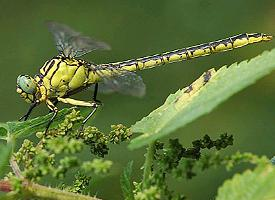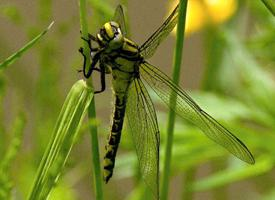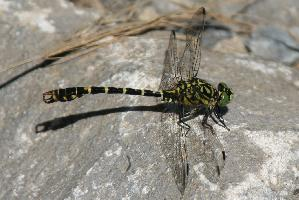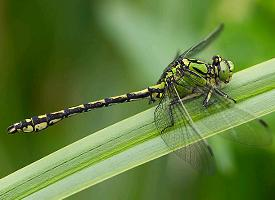
Descrierea animalului
The River Clubtail, scientifically known as Gomphus flavipes, is an intriguing species of dragonfly that belongs to the Gomphidae family. This species is predominantly found in various regions across Europe and parts of Asia, thriving along the banks of clean, slow-flowing rivers and streams.Adult River Clubtails are characterized by their elongated bodies, which can reach up to 5 centimeters in length, making them a relatively large dragonfly. Their striking appearance is marked by a robust thorax and a slender abdomen. The thorax is typically covered with a pattern of yellow and black markings that serve as a form of camouflage among the vegetation near water bodies.
One of the most distinctive features of the River Clubtail is its club-shaped tail, from which it derives its common name. The tail, or the abdomen, widens towards the end in males, giving it a club-like appearance, while females have a more streamlined abdomen. The tail segments are predominantly black with yellow rings that become broader towards the terminal segments.
The wings of the River Clubtail are clear and veined, spanning up to 7 centimeters from tip to tip when fully outstretched. Their wings are held perpendicular to the body when at rest, which is a characteristic posture of clubtail dragonflies. The pterostigma, a colored, thickened cell located near the outer edge of each wing, is long and brown, helping to balance the dragonfly during flight.
The head of the River Clubtail is relatively wide with large, compound eyes that meet at the top of the head in males, providing them with excellent vision to detect movement and catch prey. The eyes are usually a striking shade of green or blue. Their strong mandibles and mouthparts are well-adapted for grasping and consuming a variety of small insects, which make up their diet.
River Clubtail nymphs, which are the larval stage of the dragonfly, are aquatic and reside in the sediment or among aquatic plants. They have a stocky appearance with well-developed legs for crawling along the riverbed. Their gills are located within their rectum, and they breathe by drawing water in and expelling it, which can also propel them forward in a form of jet propulsion. The nymphs are predators, feeding on other aquatic invertebrates, and they can take several years to develop before emerging from the water to molt into adults.
In terms of behavior, adult River Clubtails are often seen flying low over the water, patrolling their territory, or perched on vegetation. Males are territorial and will aggressively defend their chosen stretch of river against intruders. The mating process involves a unique wheel formation where the male grasps the female behind the head, and the female bends her abdomen to receive sperm from the male's secondary genitalia.
The River Clubtail is considered an indicator species for water quality, as it requires clean, well-oxygenated water for its development. Therefore, its presence often signifies a healthy aquatic ecosystem. However, due to habitat destruction, pollution, and changes in river management, the River Clubtail's populations have faced declines in some areas, leading to conservation efforts to protect its natural habitats and ensure the species' survival.
Animale similare
Fotografii noi cu animale
Top 10 animale
- Dolphin gull (Leucophaeus scoresbii)
- Diana monkey (Cercopithecus diana)
- Moustached guenon (Cercopithecus cephus)
- Greek tortoise (Testudo graeca)
- Stone loach (Barbatula barbatula)
- Galápagos tortoise (Geochelone nigra complex)
- Japanese macaque (Macaca fuscata)
- Russian tortoise (Testudo horsfieldii)
- Common flying dragon (Draco volans)
- Galápagos penguin (Spheniscus mendiculus)


